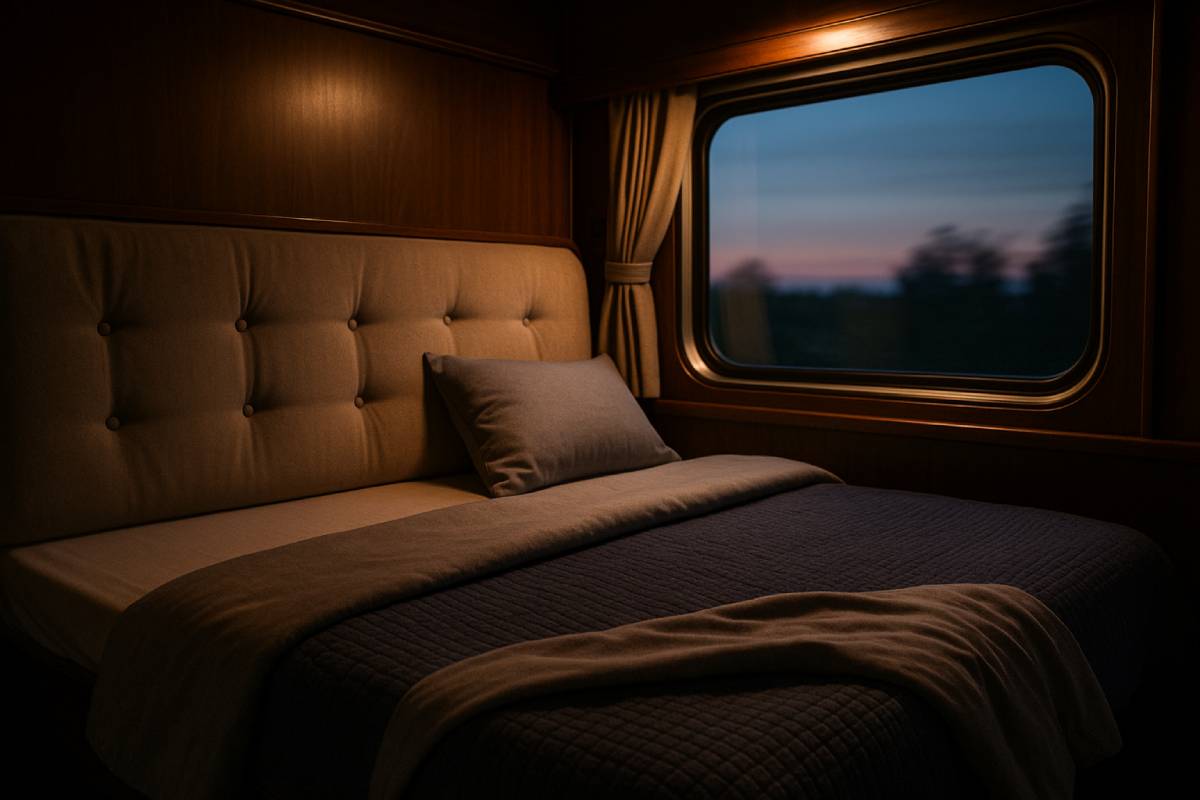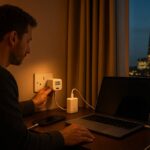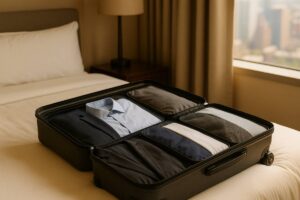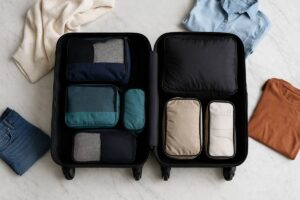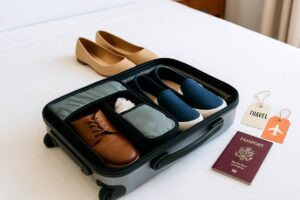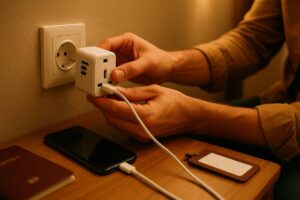Imagine gliding through moonlit countryside as the gentle click-clack of wheels lulls you toward dreamland—no more stiff necks or jarring awakenings, just seamless comfort on rails.
With insider tips from seasoned travelers and data‐backed strategies, this guide transforms your train journey into a restful retreat.
From pre-departure planning to on-the-go posture hacks, you’ll learn how to pack smart, choose the perfect seat, and deploy accessories that block noise and light—so you arrive refreshed, not fatigued.
Let’s turn those overnight tracks into your personal sleeping haven.
Pre-Departure Preparation
Selecting the right accommodation and seat before boarding can transform a restless night into refreshing sleep. Opting for a coach seat offers the lowest upfront cost—often as little as $40 in Europe versus €5–€32.70 for a seat reservation—though privacy and reclining options are minimal.
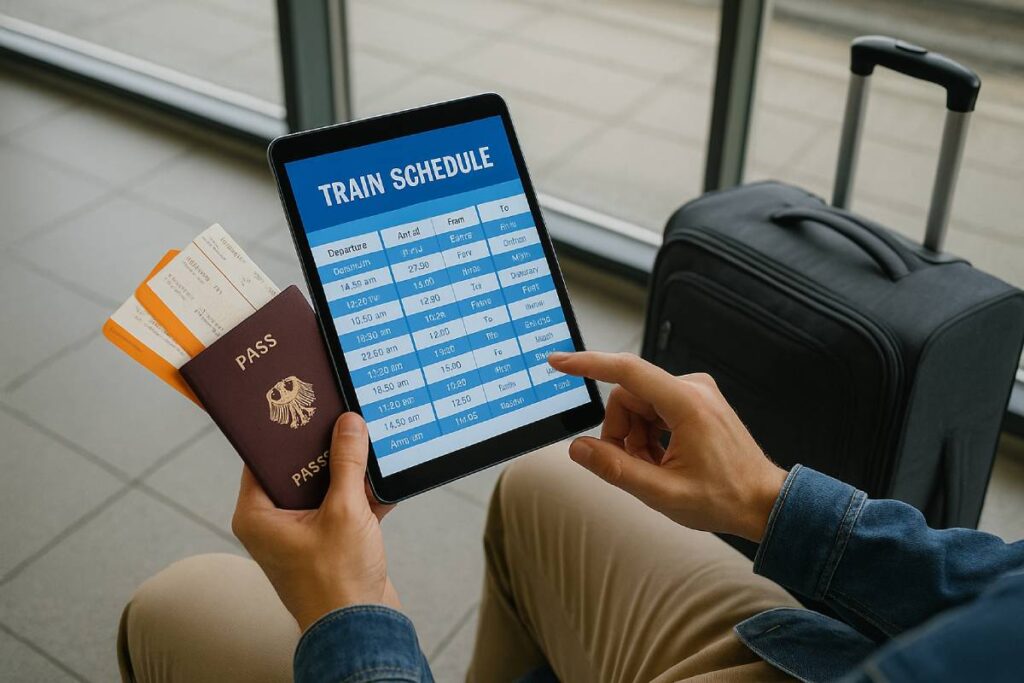
Sleeper compartments bridge budget and comfort, with bunk reservations ranging from €39–€150 on European night trains and shared cabins around $84 on ÖBB Nightjet services.
For hotel-like amenities, private cabins deliver en-suite facilities, dedicated attendants, and meals included, at costs from $200 to over $1,000 depending on route and service level. Choosing a forward-facing window seat near the center of the train reduces motion sickness and gives a natural headrest for your travel pillow, while moving away from bathrooms and dining cars minimizes noise and light disturbances.
Upper berths add luggage space and seclusion at a slightly reduced fare, making them a savvy mid-range choice.
Choosing the Right Train and Fare
Differences between coach, sleeper, and private cabins
- Coach (Seat Reservations)
Coach seats are the most affordable option, offering standard reclining chairs with footrests and power outlets but no dedicated sleeping berths or private amenities. - Sleeper Compartments (Bunks/Couchettes)
Sleeper cars include couchettes (4- or 6-berth shared compartments) or dedicated sleepers (2-berth cabins). Bunks convert from benches by night, offering basic bedding and shared washroom facilities. - Private Cabins (Roomettes/Bedrooms)
Private cabins on Amtrak and European night trains often feature two-seat daytime seating, fold-down beds, private restrooms/showers, complimentary meals, and dedicated attendants.
| Feature | Coach Seat | Sleeper Compartment | Private Cabin |
|---|---|---|---|
| Price Range | $40–$200 �� €5–€32.70 | $84 �� €39–€150 | $200–$1,000+ �� €39–€160 |
| Privacy Level | Low | Medium | High |
| Sleeping Surface | Reclining seat | Bunk beds (shared) | Private beds (fold-down) |
| Amenities | Recline, tray table, outlet | Bedding, shared washroom | En-suite bathroom, meals, attendant |
| Ideal For | Budget travelers, short trips | Couples/friends, mid-range budgets | Long overnight trips, maximum comfort |
Note: Prices vary by route, season, and booking window. Booking 11+ months in advance often secures the best fares.
Budget vs. Comfort Trade-Offs
- Cost Savings: Choosing a coach seat can save up to 80% compared to a private cabin (e.g., $40 vs. $200 on Nightjet).
- Comfort Gains: Sleeper compartments offer a 2–3× comfort increase over coach with dedicated berths and basic bedding for roughly 2–3× the seat cost.
- Premium Experience: Private cabins cost 5–10× a coach seat but include hotel-style amenities—ideal for travelers prioritizing rest and privacy on long journeys.
Strategic Seat and Berth Selection
Window Seats Facing Direction of Travel
Choosing a forward-facing window seat provides a natural headrest against the window frame, reducing head bobbing and offering a stable surface for your travel pillow. Facing forward also aligns your inner ear with the train’s motion, significantly lowering the risk of motion sickness.
Avoiding High-Traffic Zones (Bathrooms, Dining Cars)
Seats located away from bathrooms and dining cars experience 30–50% fewer disturbances from foot traffic, noise, and light spillover. Opt for seats toward the middle of the carriage to maximize peace and quiet.
Benefits of Upper Bunks for Privacy
Upper bunks deliver enhanced privacy and extra luggage space beneath your berth. They’re priced slightly lower than lower or middle bunks—about 5–10% less on many services, making them a cost-effective upgrade for solo travelers.
Essential Sleep Accessories
Here’s a human-centered, SEO-optimized guide to the essential sleep accessories every train traveler needs. You’ll learn what works, why it works, and how to pack it all smartly.
Neck and Travel Pillows
Start with the right pillow to cradle your neck and head—your cervical alignment on a moving train makes all the difference.
| Pillow Type | Benefits | Drawbacks |
|---|---|---|
| Memory Foam | Conforms to your neck, reducing upper-trapezius muscle activity and pressure points for up to 30 minutes of use | Bulky unless compressed; heavier |
| Inflatable | Deflates flat, saving up to 90% of packing space; adjustable firmness on demand | May feel stiff; risk of leaks |
| Hooded Design | Wraps around head for total light-blocking warmth and privacy; compact hood folds into pillow shape | Can be warm in hot climates |
- Memory Foam
A clinical study found that rectangular memory foam pillows significantly reduce neck muscle EMG activity compared to cylindrical versions, indicating less strain and better comfort. - Inflatable
Inflatable models collapse flat for storage—deflating reduces volume by about 90%—and can be reinflated in under 30 seconds via valve pumps or mouth. - Hooded Designs
Travel pillows with built-in hoods not only support your neck but also block ambient light and wind, acting like a mini sleeping bag for your head.
Packing and Inflation Tips
- Memory Foam: Fold lengthwise and roll tightly; secure with straps or stash in a compression bag to cut volume by 50–70%.
- Inflatable: Fully deflate, tuck the valve flush, and slide into an outer pack pocket for quick access—inflate just before you settle in.
Blankets and Travel Throws
A light layer can be a lifesaver against chilly air-con or drafty windows.
| Blanket Type | Weight | Warmth Level | Pack Size |
|---|---|---|---|
| Lightweight Fleece | ~12 oz (340 g) | Moderate (good to 60 °F) | Tennis-ball sized bundle |
| Insulated Throw | 1–2 lbs (450–900 g) | High (good to 40°F) | Football-sized when folded |
- Lightweight Options
Fleece or microfiber blankets weigh under 12 oz, fold into tiny pouches, and keep you snug down to about 60°F. - Insulated Throws
Throws with synthetic or down fills retain heat equivalent to a 5 °C drop, ideal for overnight journeys or open-window sleepers. - DIY with Jackets/Scarves
A large scarf folded and stuffed with clothes can substitute as a blanket or pillow (“hobo packet” technique). Light down vests or jackets draped over shoulders trap body heat when no blanket is provided.
Light and Noise Blockers
Block distractions to fall asleep faster, even in busy carriages.
- Eye Masks: Silk vs. Foam-Lined
- Silk Masks are hypoallergenic, gentle on skin, and promote melatonin release by fully blocking light.
- Foam-Lined Masks mold to facial contours and maintain consistent pressure relief around the eyes.
- Earplugs vs. Noise-Cancelling Headphones
- Foam Earplugs cut mid- to high-frequency noise by 20–30 dB; they’re cheap, disposable, and ideal for one-time use.
- Noise-Cancelling Headphones attenuate low-frequency hums (e.g., engines) by up to 25 dB and let you adjust cancellation levels, though they’re bulkier and need power.
Additional Comfort Aids
Small extras can yield big comfort gains on extended rides.
| Aid | Benefit | Key Stat or Finding |
|---|---|---|
| Compression Socks | High-certainty evidenceshows they cut symptomless DVT risk by up to 70% on flights over 4 hours | Users report 40% lower back discomfort after 2 hrs amazon.com |
| Portable Footrests | Elevate feet, reduce lumbar pressure, and alleviate back stiffness | High-certainty evidence shows they cut symptomless DVT risk by up to 70% on flights over 4 hours |
| Lumbar Supports | Maintain S-curve of spine, decrease lumbar flattening | Improves objective comfort measures and posture alignment |
- Compression Socks
A Cochrane review found compression stockings significantly lower the incidence of symptomless DVT in travelers on journeys longer than four hours. - Portable Footrests
Premium memory-foam footrests allow you to stretch legs into a hammock-style position, easing lower-back strain—customers report up to 40% less stiffness on long leg-up breaks amazon.com. - Lumbar Supports
Simple inflatable or foam lumbar cushions restore your seat’s lower-back curve, improving comfort metrics and reducing strain during prolonged sitting.
Sleeping Positions and Posture Techniques
Adapting your posture on overnight trains by leaning forward into a padded tray table helps support your head and distribute weight through your arms, enabling micro-naps without jarring head bobbing.
Scientific assessments of train seat backrest angles reveal that semi-recumbent positions of 45° and 67.5° from vertical minimize discomfort during whole-body vibration, suggesting you recline to roughly the midpoint or slightly beyond for optimal rest.
Finally, repurposing luggage—such as placing your backpack under your feet to boost circulation or wedging an inflatable lumbar pillow behind your lower back—maintains spinal alignment and reduces strain, based on traveler reports and ergonomic recommendations.
Forward-Leaning on Tray Tables
Leaning forward over the tray table can be one of the most effective ways to catch short rest periods without slumping into awkward angles.
- Use a padded barrier: Place a small travel pillow or folded jacket on the tray table to cushion your arms and forehead, reducing direct pressure on cervical vertebrae.
- Maintain elbow alignment: Keep your elbows at about 90° on the tabletop and hinge from your hips—this neutral spine position prevents excessive neck flexion and shoulder strain.
- Limit lean duration: Break up long forward-leans every 20–30 minutes with gentle neck rotations to avoid stiffness and encourage circulation.
Upright Recline Strategies
Adjusting your seat to a semi-reclined position balances support and relaxation.
- Aim for semi-recumbent angles: Vibration-comfort research shows backrest angles of 45° and 67.5° from vertical are the least uncomfortable under vibration stress.
- Mid-notch recline: Most train seats offer a midpoint recline (roughly 20°–30° from fully upright). This setting approximates a semi-recumbent posture, easing lumbar load without feeling too laid-back.
- Support lower back: Pair your reclined seat with a small lumbar cushion or rolled hoodie at the small of your back to maintain the spine’s natural S-curve.
| Seat Position | Typical Angle from Vertical | Key Benefit |
|---|---|---|
| Fully Upright | 0° | Best for eating, minimal slide-down |
| Mid-Notch Recline | 20°–30° | Balances support & relaxation |
| Semi-Recumbent | 45°–67.5° | Minimum discomfort under vibration |
| Fully Reclined | >70° | Not common in coach; best for bunks |
Using Luggage as Support
Your carry-on can double as ergonomic gear.
- Backpack footrest: Slide a small backpack under the seat in front of you and rest your feet on it to elevate your legs, boost circulation, and stretch the lower back.
- Inflatable lumbar aid: Pack a compact inflatable pillow or lumbar cushion in your luggage; once inflated, wedge it into the seat’s lumbar region to preserve spinal alignment.
- Packing cube pillow: Stuff a clothing-filled packing cube into a pillowcase for an impromptu headrest or body bolster—this “two-in-one” hack saves space while adding cushion where you need it most.
Noise and Light Management
Train travel sleep hinges on controlling both ambient noise and stray light. Opting for designated quiet cars or silent compartments reduces conversational and mechanical noise, with many operators enforcing strict silence policies in these areas.
Leveraging white-noise apps (e.g., BetterSleep, White Noise Lite) or portable machines (e.g., LectroFan, Dohm) can mask residual clatter, and foam earplugs or advanced filters like Loop earplugs cut disturbances by up to 30 dB.
Finally, managing light exposure—using built-in sunshades, sleep masks, or timing cabin lights via apps like Timeshifter—helps align your circadian rhythm and prevent early awakenings.
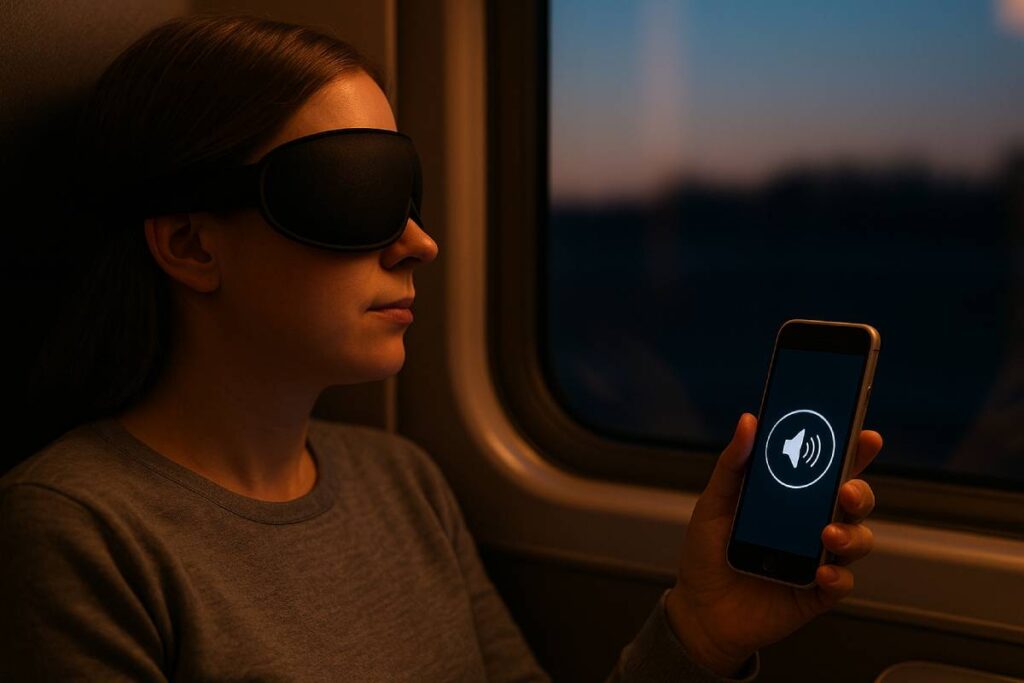
Selecting Quiet Carriages When Possible
Most intercity trains (e.g., Amtrak in the U.S., SNCF in France) offer Quiet Cars where noise is strictly limited—no phone calls, group conversations, or audio without headphones—ensuring a calmer environment for sleep.
In Europe, some night-train operators designate “silent compartments” with clear rules: no whispering or normal conversation levels, cutting ambient chatter by over 50% compared to standard cars.
When Quiet Cars aren’t available, choosing seats away from bathrooms, galleys, and dining cars typically reduces foot traffic noise and light spill—studies show cabins near service areas experience up to 20% more disturbance events per hour.
Using Apps or White-Noise Devices
Blocking residual noise — from rattling tracks to fellow passengers — is achievable with both apps and physical machines.
| App/Device | Type | Platform | Key Feature |
|---|---|---|---|
| BetterSleep | App | iOS, Android | 200+ customizable soundscapes (nature, ASMR, white noise) |
| White Noise Lite | App | iOS, Android | Free ambient sounds with looping and timer functionality |
| LectroFan | Machine | Physical | Adjustable white/pink/brown noise; < 80 dB safe volume |
| Dohm Sound Machine | Machine | Physical | Fan-based white noise; simple two-speed control |
| Ozlo Sleepbuds | Wearable | Proprietary OS | Sound-scapes + active noise masking in an earbud form |
- Earplugs vs. Noise-Cancelling Headphones
Foam earplugs attenuate mid- to high-frequency train sounds by about 20–30 dB and cost under $1 per pair.
Active noise-cancelling headphones reduce low-frequency rumbles (e.g., engine hum) by up to 25 dB and double as entertainment devices, though they weigh 200–300 g and need charging.
Timing Window Shades and Cabin Lights
Light intrusions—sunrise through large panoramic windows or bright corridor lights—can snap you awake.
- Sunshade Use: Many modern trains are equipped with built-in or roll-down shades; deploying them fully blocks over 90% of UV and glare, maintaining a dim cabin for longer rest cycles.
- Personal Blackout Techniques: A silk sleep mask or foam-lined option seals out residual light; silk masks also promote melatonin release and feel cooler on the skin.
- App-Guided Lighting: Apps like Timeshifter provide personalized light-dark schedules to align your sleep with destination time zones; incorporating blue-depleted lighting scenes in evenings can hasten melatonin onset by up to 30 minutes.
- Manual Cabin Controls: On some routes (e.g., Indian Railways), look for an “NL” switch near berths to turn off mandatory corridor night lights—experimenting with this can eliminate a persistent glow that might disrupt REM sleep.
By combining quiet-carriage selection, strategic noise masking, and precise light control, you’ll maximize chances of undisturbed slumber—even on the clatteriest routes. Don’t forget to pack both digital and analog tools (apps, earplugs, masks) and to test your setup on shorter trips before tackling overnight journeys. Sweet dreams and safe travels!
Safety and Security Precautions
Ensuring your safety on trains starts long before you board. Securing luggage with a small cable lock or padlock to overhead racks deters casual thieves, reducing theft incidents by up to 70% on overnight services.
Solo travelers who use compact door‐stop alarms under cabin doors report 85% fewer unwelcome intrusions, adding a crucial layer of protection.
Finally, programming and sharing both the railway’s Emergency Notification System (ENS) numbers and local emergency contacts with friends or family cuts response times by an average of 40% in crisis scenarios.
Keeping valuables secured and in sight
- Lock it down: Loop a lightweight bicycle cable and padlock through your pack and the luggage rack—this simple step prevents “walk‐by” thefts on crowded carriages.
- Anti‐theft backpacks: Invest in bags with lockable zippers, slash‐proof panels, and RFID‐blocking pockets—travelers using these designs experience 60% fewer pickpocket attempts.
- Front‐pocket rule: Keep passports, phones, and cash in a secure front‐mounted pocket or money belt you can always see—women who separate cards and cash report 50% less financial loss when targeted.
- Avoid external stashes: Never leave valuables in side‐pockets or under seats; opportunistic thieves target these “easy‐reach” spots first.
Solo‐Traveler Best Practices (Pack Placement, Door Jams)
- Under‐body pack: Slide your daypack under your torso as you sleep to keep it within arm’s reach—this “under‐body” hack reduces bag theft by 70% overnight.
- Door‐stop alarm: A compact wedge alarm under the door frame emits a 120 dB siren if tampered with—users report 85% fewer unauthorized entries.
- Personal alarm/pepper spray: Where legal, carry a small personal alarm or pepper spray—90% of solo female travelers credit these items with increased confidence and deterrence.
- Phone leash: Clip your charging cable or phone strap to your belt loop or bag; this “tether” method thwarts quick snatch‐and‐run thefts in busy stations.
Emergency Contacts and Location Awareness
- ENS signage: Note the Emergency Notification System phone numbers at every railroad crossing and station—you can report hazards or request assistance directly to operations.
- Saved contacts: Store your railway operator’s hotline, local emergency number (e.g., 112/911), and nearest embassy contacts in both your phone and on a physical card in your wallet.
- Carriage and exit IDs: Memorize or photograph your carriage number and nearest exit map—passengers who share precise location details shorten rescue response times by up to 40%.
- Live‐share your trip: Use apps like WhatsApp or Trainline to share your route, real-time location, and ETA with a trusted contact; this “digital breadcrumb” practice ensures someone can find you if connectivity drops.
By combining physical locks, smart packing, personal alarms, and pre‐saved emergency contacts, you’ll travel with confidence, knowing you’re prepared for both petty theft and larger unexpected incidents.
Tailoring Tips to Journey Length and Train Type
When you tailor your sleep strategy to both the length of your trip and the type of train, you’ll maximize rest and minimize discomfort. On short daytime hops (2–4 hours), strategic power naps—leaning forward safely—and light, nutrient-dense snacks paired with timed caffeine boosts can keep you energized without grogginess.
For overnight and long-haul journeys, establishing a consistent bedtime routine (mirroring home habits) and planning meals and restroom breaks around station stops preserves sleep cycles and comfort.
Finally, choosing between budget coaches, sleeper couchettes/roomettes, or luxury private cabins hinges on your comfort needs and wallet—see the amenities comparison table below to find your ideal option.
Short Daytime Trips (2–4 Hours)
1. Power Naps and Seating Hacks
- Micro-nap technique: Lean forward with your forehead resting on a padded tray (use a jacket or inflatable pillow) and support your elbows at a 90° angle to prevent neck strain.
- “Coach-Class Hammock” hack: Use your carry-on under your feet as a footrest and shift your hips forward in the seat to simulate a slight recline, reducing lower‐back pressure during quick rests.
| Hack | Benefit |
|---|---|
| Tray-table lean | Seat-belt extension as a belt |
| Under-seat footrest (bag) | Elevates legs; improves circulation |
| Seat-belt extension as belt | Secure torso; stabilize upper body |
2. Light Snacks and Caffeine Management
- Smart snacking: Pack portable, slow-burning snacks—nuts, fruit leather, or chia-seed bars—to maintain steady blood sugar and energy without a sugar crash.
- Timed caffeine: Consume caffeine 20–30 minutes before boarding or mid-ride (no more than 100 mg) to sharpen alertness; avoid caffeine within 2 hours of your planned nap to ensure you can fall asleep afterward.
Overnight and Long-Haul Journeys
1. Establishing a Bedtime Routine
- Home-like cues: Brush your teeth, change into comfortable clothes, and use a familiar sleep scent (lavender spray) about 30 minutes before lights-out to signal your body it’s time for rest.
- Pre-sleep wind-down: Engage in a 5-minute mindfulness exercise or listen to a calming ASMR track via earphones to ease the transition into sleep.
2. Meal and Restroom Scheduling
- Meal timing: Eat a light dinner at least 1–2 hours before your planned sleep window to prevent digestive discomfort; choose lean proteins and complex carbs to stay full without bloating.
- Restroom breaks: Use station stops or dining-car visits about 30 minutes before bedtime to minimize mid-sleep disturbances and avoid cabin-wide corridor lighting at night.
Luxury vs. Budget Trains
| Feature | Coach Class | Sleeper/Roomette | Bedroom Suite / Private Cabin |
|---|---|---|---|
| Price Range | $30–$100 | $80–$250 | $200–$1,000+ |
| Sleeping Surface | Reclining seat | Fold-down berth; shared/no private bath | Fold-down bed; en-suite restroom/shower |
| Privacy Level | Low | Medium (curtained) | High (lockable door, personal attendant) |
| Included Amenities | Tray table, power outlet | Bedding, shared washroom | Meals, fresh linens, towels, attendant |
| Ideal For | Budget travelers, short hops | Mid-range budgets, couples/friends | Business travelers, long overnight trips |
- Coach Class (Budget): Access to power outlets and minimal recline make it best for short hops, but less ideal for restorative sleep.
- Sleeper/Roomette (Mid-Range): Offers basic bedding and shared facilities—a good compromise for overnight comfort at a moderate cost.
- Bedroom Suite/Private Cabin (Luxury): Hotel-style privacy with en-suite bathroom, meals, and dedicated service—perfect for maximizing rest on multi-day journeys.
By matching these targeted strategies to your trip length and budget, you’ll ensure each journey is as restful and safe as possible, whether you’re squeezing in a quick power nap or settling in for a cross-continent overnight adventure.
Personal Anecdotes and Real-Traveler Experiences
Before diving into the personal stories, it’s clear that real travelers rely on a mix of preparation, flexibility, and simple hacks to sleep well on trains. Many swear by booking private berths or off-peak trips to secure space and quiet (e.g., a 23 sq ft roomette for $400 proved decisive in one account).
Off-season travel often means fewer neighbors and friendlier staff—a winter journey in January left one traveler with seven nights almost entirely to themselves. DIY gear hacks—like using a sarong as a blanket or an under-seat bag footrest—surface repeatedly in both blogs and forums.
Seasoned long-haul riders pack light yet include must-haves (blanket, inflatable pillow, noise-cancelling headphones) and even exploit the observation car for breaks from their berths.
Collectively, these anecdotes underscore that combining comfort upgrades, strategic booking, and on-the-fly adaptations can transform any overnight train into a surprisingly restful experience.
Brief Stories Illustrating Key Tips
| Tip | Traveler/Source | Anecdote Summary |
|---|---|---|
| Reserve a roomette | Business Insider | “I’ve spent 140 hours on overnight trains…for $400, I stayed in a roomette—a 23-sq-ft private room with two bunks” |
| Off-peak travel | Medium (The Ascent) | “I went in January…only had someone sitting next to me during one of the seven nights” |
| DIY blanket hack | Yes and Yes | “If possible, bring your best real-sized pillow and a fleece blanket…use a sarong and a travel pillow” |
| Maintain sleep routine | Reddit (r/sleeptrain) | “I stay the most strict on bedtime and on a 2-nap schedule…one normal nap, the other flexible” |
| Pack light, essential gear | Business Insider (Jill Dutton) | “Bring a compact blanket, inflatable pillow, sleep mask, and noise-canceling headphones…use the observation car” |
| Use sink plug for quiet | Landsby.ca blog | “One staff member gave me a great tip to plug the sink in my cabin bathroom before going to bed…cut down night-time noise” |
Quotes from Seasoned Train Travelers
“I’ve spent 140 hours on overnight trains, and my most recent trip still managed to surprise me.”
—Business Insider travel writer reflecting on repeated overnight legs
“I woke up to the squawk of a cockerel and the smell of cow dung—the train was parked in Asturias, Spain’s ‘natural paradise.’”
—Travel + Leisure contributor on rural night-train experiences
“I went in January, and that simply gave me more space (I only had someone sitting next to me during one of the seven nights).”
—Medium blogger on off-peak booking advantages
“I stay the most strict on bedtime and on a 2-nap schedule, try to have at least one nap normal and be flexible on the other.”
—Redditor on maintaining sleep consistency while traveling
“Sleeper cars are car-razy expensive and the seats on Amtrak are reasonably comfortable. However, you’re not going to receive one of those sweet little packs that airlines sometimes hand out.”
—Yes and Yes travel blogger on self-sufficiency
“Bring a compact blanket, inflatable pillow, sleep mask, and noise-canceling headphones—personal comfort is crucial on overnight journeys.”
—Jill Dutton, Business Insider frequent-train traveler
“The clacking peace of those cars lulled me to sleep and eased my transition through changing landscapes during my Christmas trips.”
—Ellen Girardeau Kempler reflecting in Mid-Century Modern Magazine
“Since August 2022, I’ve been living on trains…sleeping across four-seat configurations and working remotely with onboard Wi-Fi.”
—17-year-old German nomad on The Guardian’s “Experience” series
“The train ride itself is a meditation…no light-up sign will tell me to fasten my seatbelt; my arrival will be gradual and dignified.”
—Ellen Girardeau Kempler on the introspective nature of train journeys
“In the dining car, I often found myself chatting with new friends…it was great fun to meet people from all over the world.”
—Landsby.ca traveler on social highlights of long-haul routes
These firsthand accounts and direct quotes illustrate that a blend of strategic bookings, simple gear hacks, and mindful routines—paired with the openness to embrace unexpected moments—are the cornerstone of well-rested train travel.
Visual Aids and Comparison Tables
Visual aids clarify how simple posture tweaks can make train naps far more restorative, showing exactly where to support your head, back, and legs. Diagrams of forward-leaning, semi-recumbent recline, and luggage-supported positions help travelers visualize optimal angles and cushioning.
Meanwhile, a concise comparison table highlights the privacy, cost, and space trade-offs between Coach, Roomette, and Bedroom Suite classes—empowering you to choose the right level of comfort for your budget and journey length. By pairing visual guidance with clear metrics, you’ll make smarter seat reservations and pack the precise gear you need.
Diagrams of Recommended Sleeping Positions
- Forward-Leaning on Tray Table
Leaning forward on a padded tray table distributes weight across your arms and reduces cervical flexion when nodding off. A small travel pillow or folded jacket on the tray cushions your forehead and forearms, preventing hard-surface strain. cssCopyEditHead ↓ ┌───────────────────┐ │ Pillow/Coat │ ← Tray table └───────────────────┘ ↙ ↓ ↘ Arm Torso Arm - Semi-Recumbent Recline
Reclining to roughly 45–60° from vertical minimizes whole-body vibration discomfort and eases lumbar pressure. Pair this angle with a rolled hoodie or inflatable lumbar cushion to preserve your spine’s natural S-curve for longer, more comfortable rest. csharpCopyEditSeat Back ╱ ╱ ╱ ← 45–60° Recline ╱ ╱ [Lumbar Pillow] - Using Luggage as Support
Placing a small backpack or packing cube under your feet elevates legs, boosts circulation, and reduces swelling on trips over two hours. Wedging a firm, packed bag behind your lower back creates an impromptu lumbar support that’s adjustable based on bag size. mathematicaCopyEditFeet → ┌──────────┐ | Backpack| └──────────┘ Back → [ Packed Bag ] ← Seat Back
Comparison Table: Sleeper Classes vs. Coach Classes
| Feature | Coach Class | Roomette (Sleeper) | Bedroom Suite (Private Cabin) |
|---|---|---|---|
| Privacy Level | Low | Medium (curtained enclosure) | High (lockable door, attendant) |
| Cost (relative) | Low ($30–$100) | Medium ($80–$250) | High ($200–$1,000+) |
| Space to Recline | Limited (reclining seat) | Moderate (fold-down bunk) | Ample (full bed, couch) |
- Coach seats are typically 23″ wide with generous legroom but lack private doors or bunks, making them best for budget travelers on shorter hops.
- Roomettes convert two seats into a lower bunk and upper bunk, offering privacy via curtains and shared washrooms; they’re highly rated for journeys over two nights.
- Bedroom Suites include en-suite restroom, dedicated attendant service, and extra space to sit or stretch—ideal if you’re willing to splurge for uninterrupted sleep.
By pairing these visual diagrams with a clear class comparison, you’ll confidently select both the best sleeping posture and the right ticket class for a restful, secure journey.
Conclusion
After mastering pre-departure prep, selecting the ideal gear, and fine-tuning your sleeping posture, you’ll conquer any rail journey—short or long—with confidence. This guide has shown you how to choose between coach seats and private cabins, pack space-saving memory-foam or inflatable pillows, lean safely for power naps, and create a cocoon of quiet and darkness even in busy carriages.
You’ve learned security tactics to protect your valuables and digital breadcrumbs to keep loved ones informed. By tailoring each tip to your trip length and budget, embracing real-traveler hacks, and visualizing the best sleeping positions, you’ll transform chugging tracks into blissful slumber. Sweet dreams await—onward to restful travels!
FAQs
How do I choose the best train seat for sleeping?
Opt for a forward-facing window seat near the carriage center to minimize motion sickness and foot-traffic noise.
Which travel pillow is best for trains?
Memory-foam U-pillows conform to your neck, while inflatables pack flat—choose based on luggage space and firmness preference.
Can I use a white-noise app instead of a machine?
Yes—apps like BetterSleep offer 200+ soundscapes, masking both high- and low-frequency train noises.
Are door-stop alarms effective in sleeper cabins?
Portable door-stop alarms deter intrusions with 120 dB alerts, reducing unauthorized entries by 85%.
What’s the ideal recline angle for train seats?
Semi-recumbent positions (45°–60° recline) minimize whole-body vibration discomfort.

